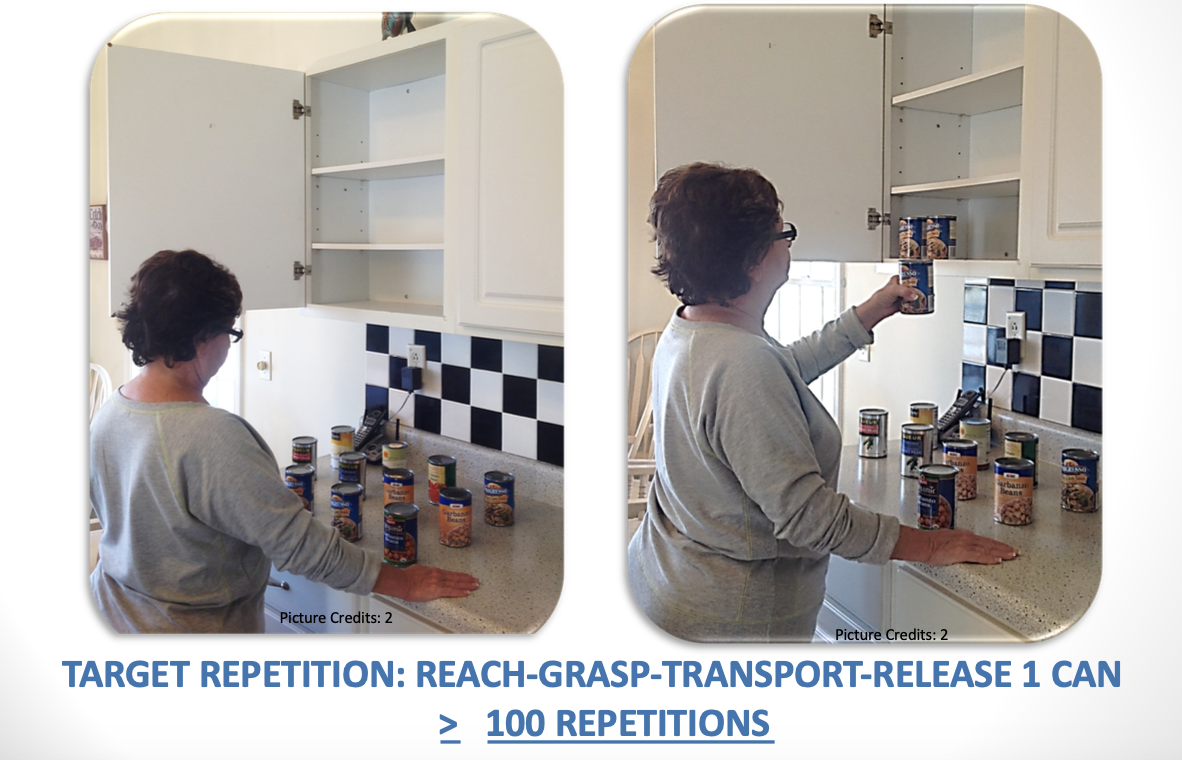neuroplasticity
1/29
There's no tags or description
Looks like no tags are added yet.
Name | Mastery | Learn | Test | Matching | Spaced |
|---|
No study sessions yet.
30 Terms
overview: ***what is plasticity?
***neuroplasticity involves
the ***brain’s capacity to physically change ***in response to ***development, ***experience, ***damage, or ***dysfunction
plasticity mechanisms:
***describe the neural mechanisms related to plasticity
axonal sprouting
dendritic branching/spine formation and elimination
pruning
synapse strength alterations- LTP; LTD
***describe mechanisms related to functional modular plasticity, including homologous area adaptation, cross-modal reassignment, map expansion, and compensatory masquerade
axonal sprouting
dendritic branching
pruning
synaptic plasticity
homosynaptic plasticity
heterosynaptic plasticity
***functional modular plasticity (highest level of neuroplasticity- involves ***cooperation of neural networks in ***specific regions of the brain/or ***across various regions of the brain)
homologous area adaptation
cross-modal reassignment
map expansion
compensatory masquerade
plasticity mechanisms:
***describe the neural mechanisms related to plasticity
axonal sprouting
axonal sprouting
axon= end of the neuron, which sends the message out towards other neurons
sprouting= where new axons grow
==> happens during ***fetal development but can also happen ***as a result of injury, and it would be ***driven by engagement in activity
***new growth from growth cone (which probes the environment in search of a target) – ***developing axons
growth cone is the navigator of the axon-“fan shaped” distal tip of the axon that ***probes the environment by extending and retracting membranous projections called filopodia (finger-like projections of bundled actin) & lamelliopodia (sheet-like projections formed by a meshwork of actin)
axon outgrowth and guidance to targets depend on the coordination of cytoskeletal proteins (actin and microtubules) and environmental guidance cues
***protrusion: ***extension of new membrane at the edges of the growth cone
***engorgement: ***microtubule-driven transport of organelles and vesicles ***into the peripheral regions
***consolidation: ***stabilization of the proximal portion growth cone ***into a cylindrical axon shaft, ***creating the axon as it continues to grow
==> these ***axon outgrowth stages ^^^ ***occur in response to environmental cues (i.e., factors in the environment that call out to the ***growth cone or ***repel the growth cone)
***collateral sprouting from healthy axons: ***allow axons to make multiple connections with various targets
occurs during development and in response to injury/disease
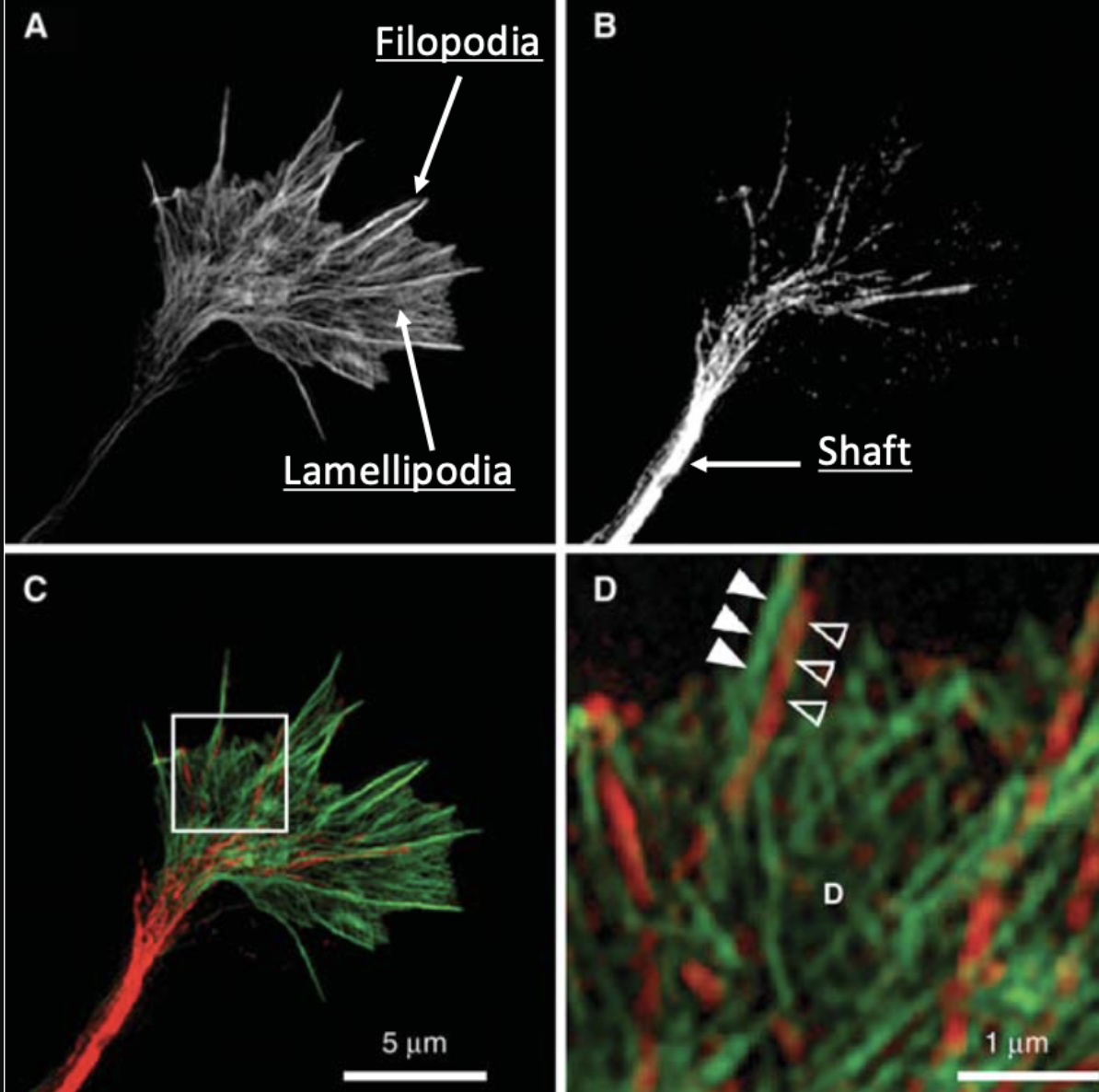
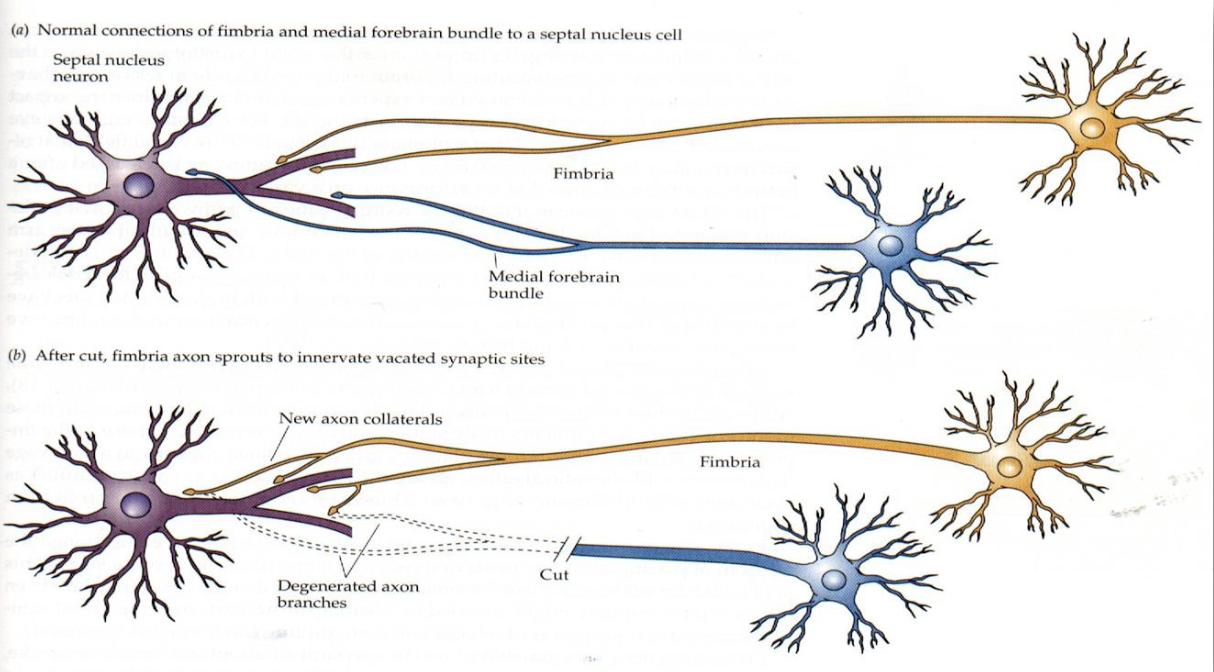
***describe the neural mechanisms related to plasticity
axonal sprouting
top image: healthy normal synaptic connections
each neuron has sprouted a collateral, either during development or as a result of training
bottom image:
blue neuron’s axon has been cut
yellow neuron’s ***axons are growing new sproutings to ***take over the area which had been connected to the blue neuron
even though we ***cannot regenerate the axon that’s lost from the blue neurons, there’s ***still a possibility of regaining function because of the plasticity that’s occurring
cross-modal plasticity (e.g., what happens during phantom-limb pain)
plasticity mechanisms
***describe the neural mechanisms related to plasticity
dendritic branching/spine formation and elimination
dendritic branching and spine formation
dendrites= where the action is; can branch extensively
involves cytoskeletal proteins (predominantly actin)
occurs during ***development and in ***response to experience
***dynamic process: ***branching and ***spine remodeling correlates with ***enriched environments, ***learning, and ***memory
dendritic spine morphology varies between apical and basal dendrites
functional differences?
apical dendrites may be more sensitive to age-related changes
***abnormalities in ***dendritic branching and spine formation are implicated in ***brain disorders (e.g., ASD, schizophrenia)
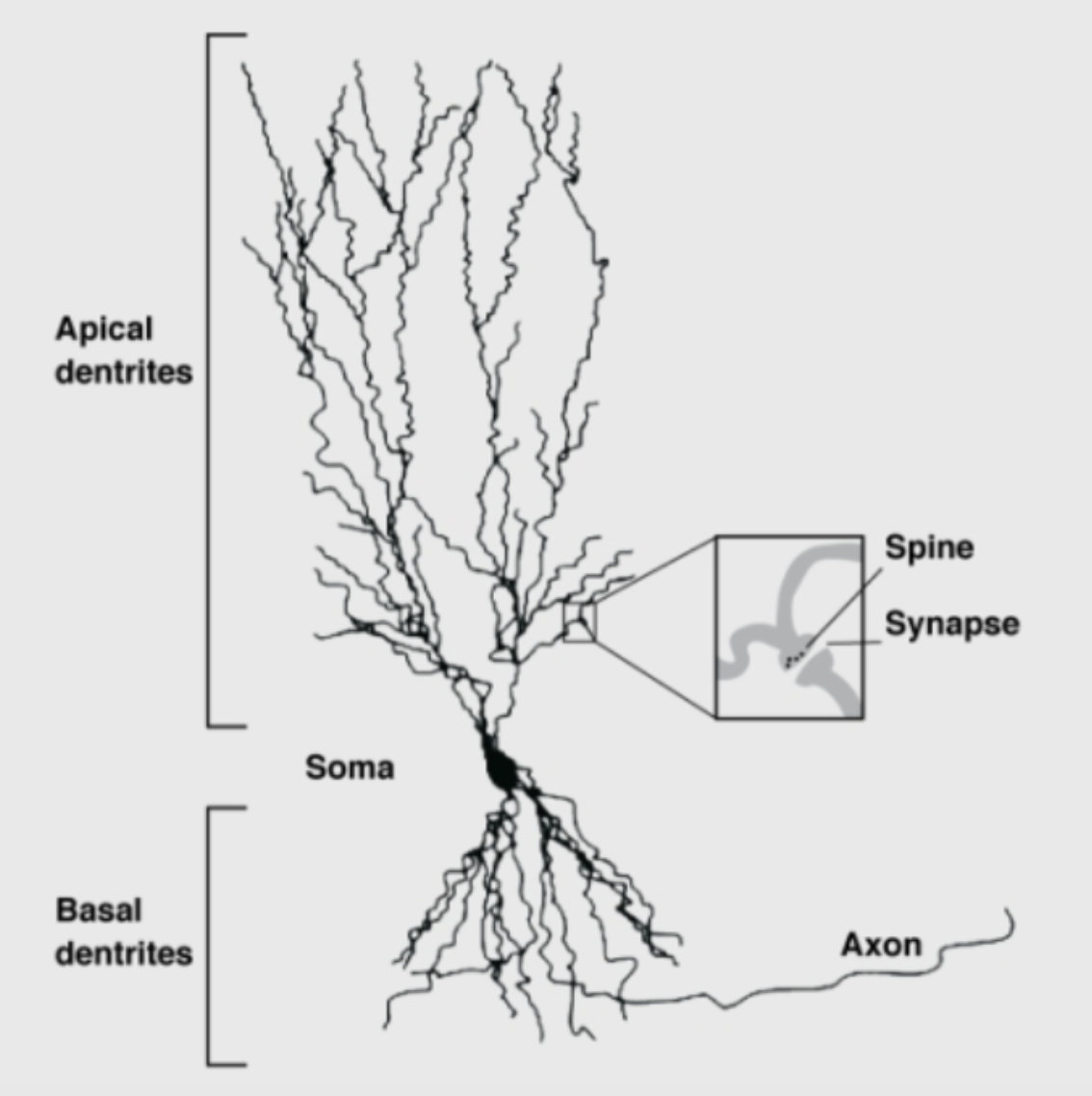
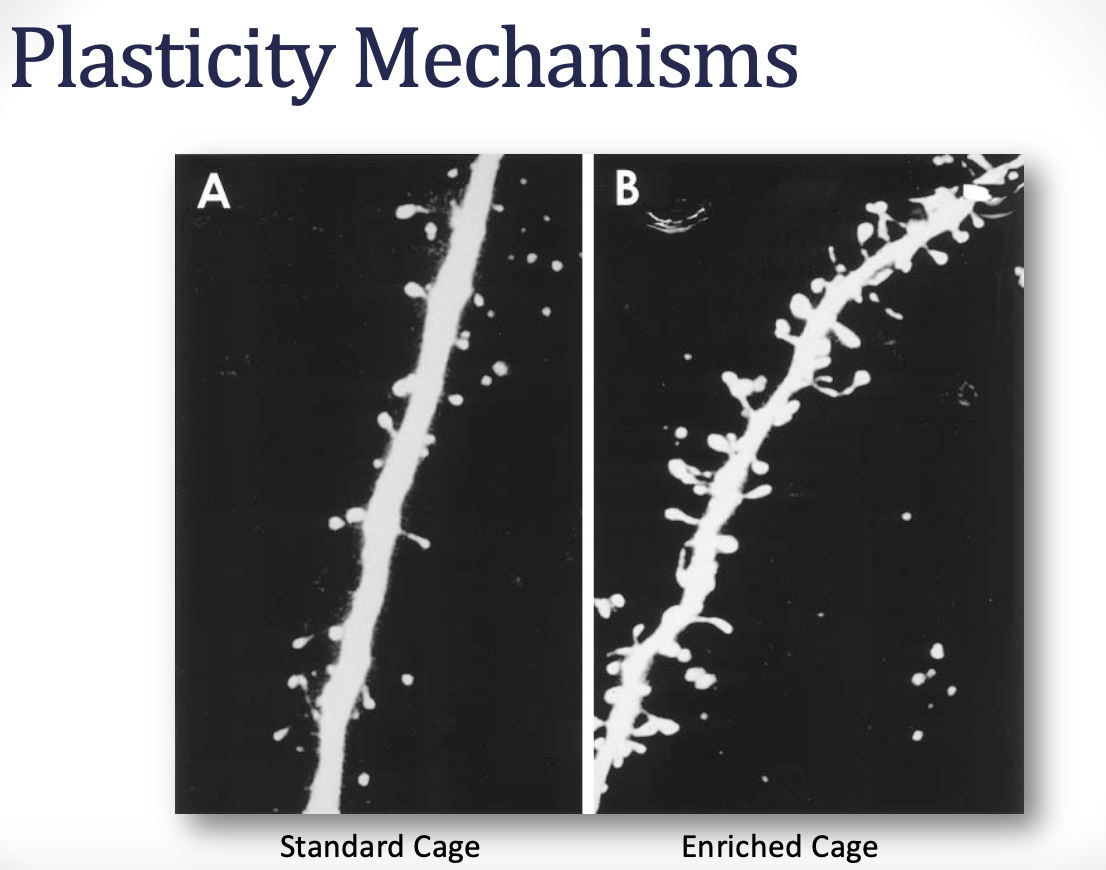
***describe the neural mechanisms related to plasticity
dendritic branching/spine formation and elimination
comparison of dendritic spines of rats that were in a standard cage vs an enriched cage (enriched cage involving challenges and experience)
***enriched cage
***more dendritic branches
***spines are firmer
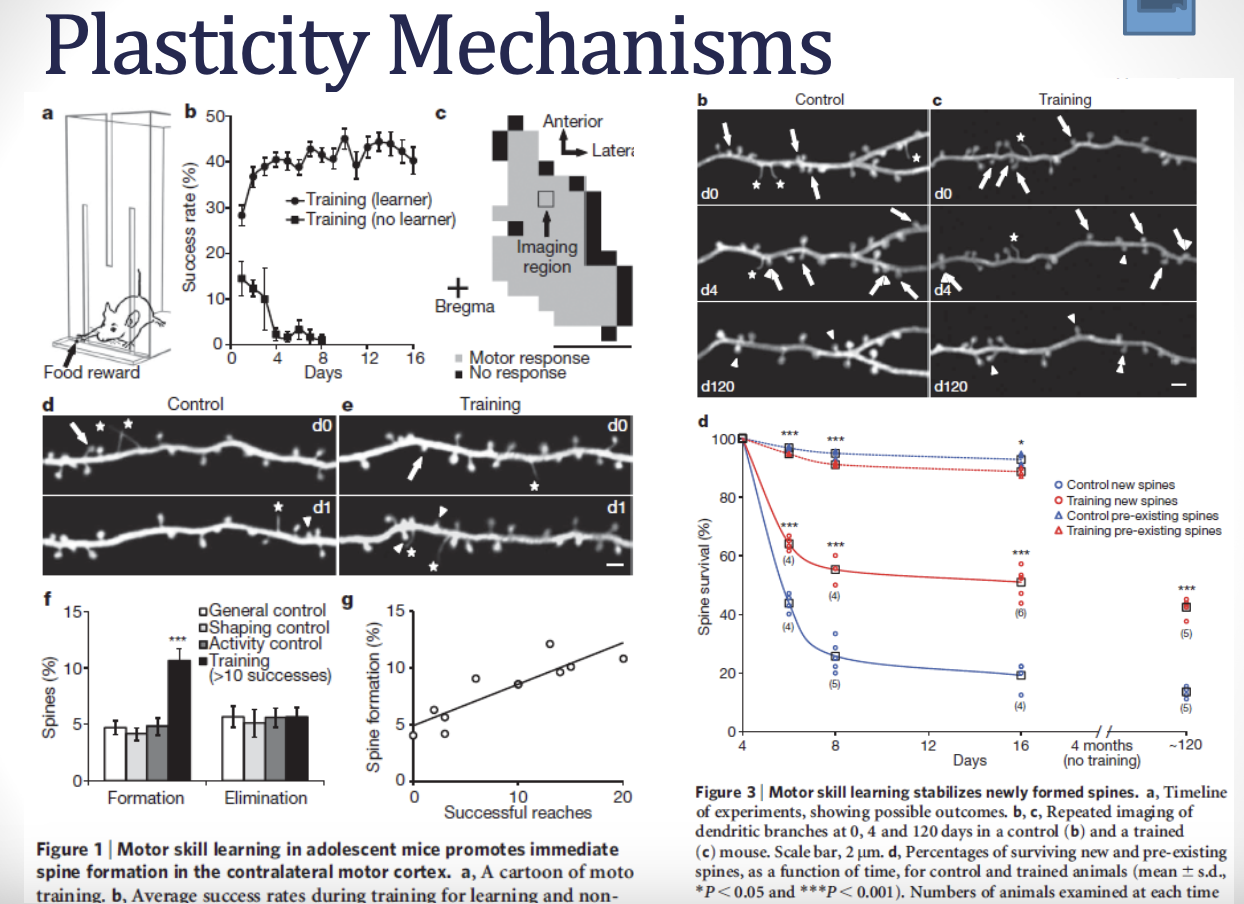
***describe the neural mechanisms related to plasticity
dendritic branching/spine formation and elimination
formation, elimination, and stabilization with motor learning in rats
rats who had been ***trained in motor skill learning
—> ***formation of new spines, with spine formation doubling that of the control mice
—> but, no difference in spine elimination between the 2 groups
the ***more successful reaches that were had, the ***more spine formation occurred (linear correlation)
== final finding: training that involves ***learning a skilled movement, ***rather than other training-related experiences/***other unskilled motor activity, ***drives spine formation (i.e., ***not just movement in general, ***but learning a skill!)
== also found: ***direct link between ***learning and ***spine formation
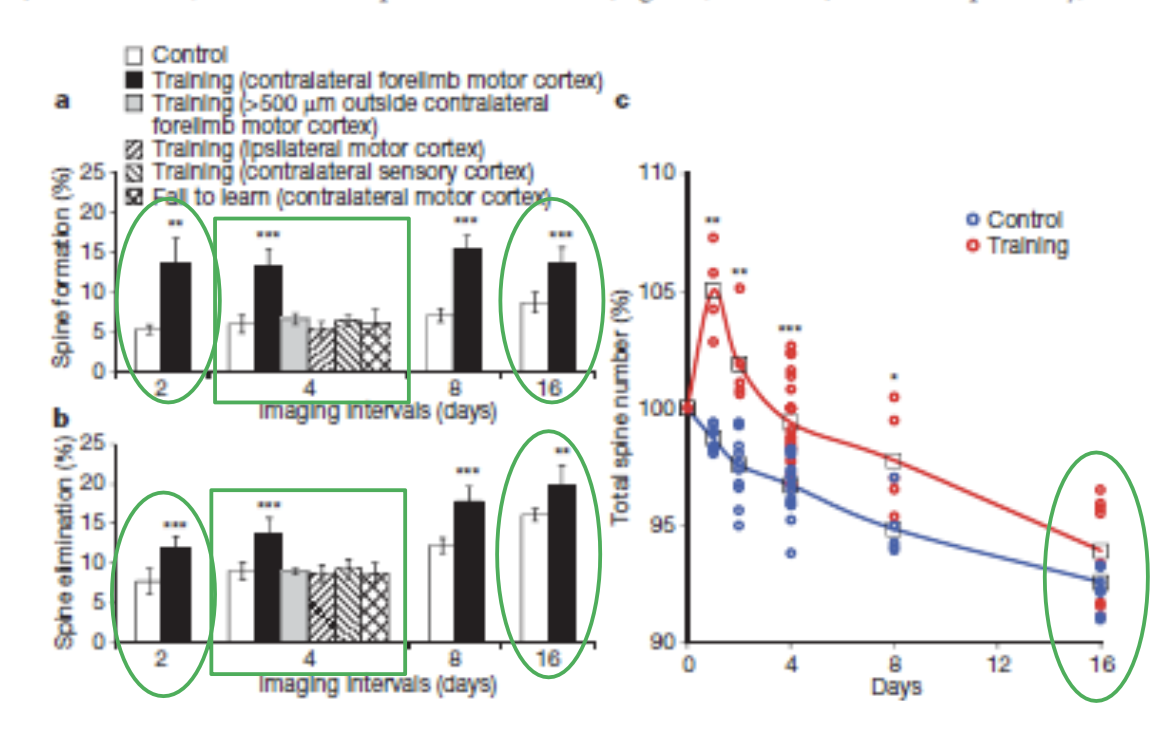
this study ***looking at skill acquisition in mice showed that specific ***training conditions lead to ***reorganization of the ***primary motor cortex
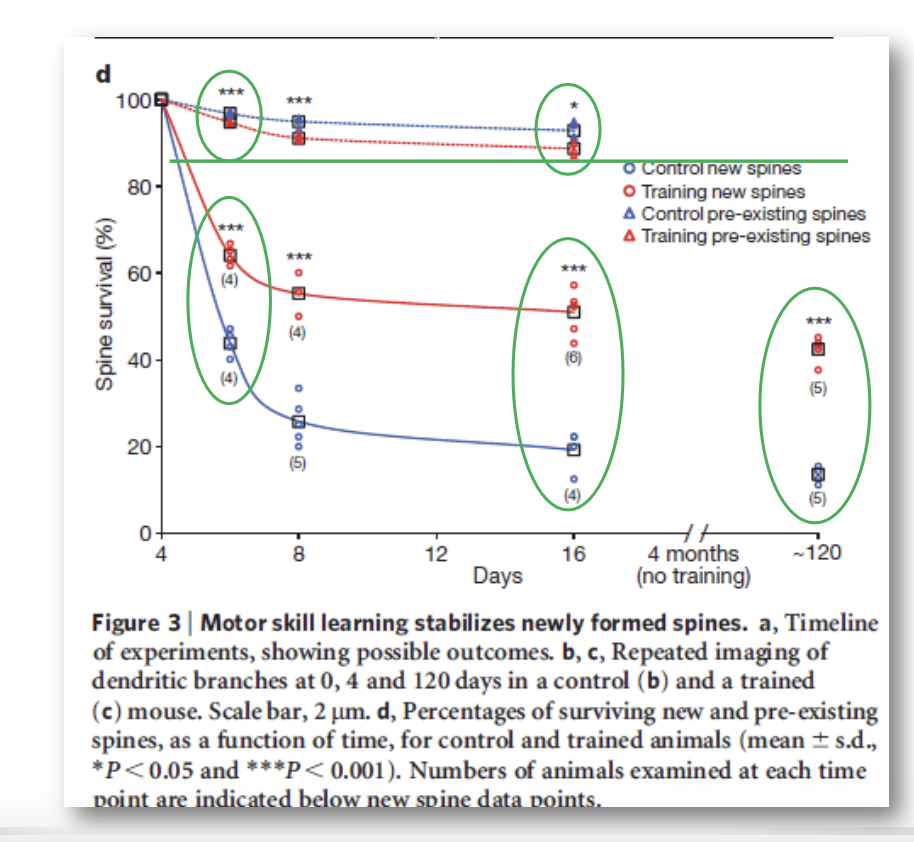
***describe the neural mechanisms related to plasticity
dendritic branching/spine formation and elimination
study examined the relative stability of new and pre-existing dendritic spines
***pre-existing spines are ***pretty stable
***new spines are ***less stable than the pre-existing ones; there are also a lot less of them
must go through ***prolonged selection ***before stabilization occurs
but, the ***training group does retain more of the new spines than the control group does
== suggests that ***motor learning selectively ***stabilizes ***learning-induced spines and ***destabilizes pre-existing spines
==> the ***consolidation process that ***leads to motor memory
plasticity mechanisms
***describe the neural mechanisms related to plasticity
pruning
synaptic pruning
throughout the course of development, ***neurons are constantly making connections, ***making many more than we need
the process of pruning allows us to ***keep only what’s essential
***synapses are ***removed naturally as ***part of brain maturation
***irregular or abnormal pruning, however, is associated with possible ***mental health disorders (e.g., resulting in problems with social cognition)
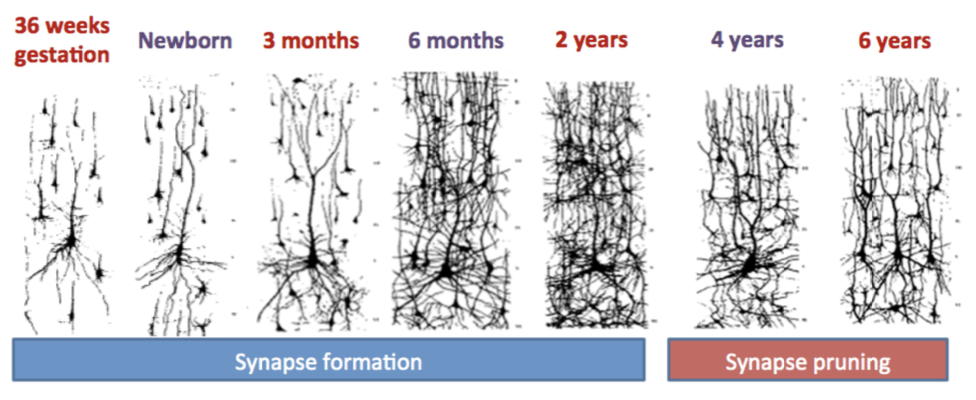
plasticity mechanisms
***describe the neural mechanisms related to plasticity
axonal sprouting
dendritic branching/spine formation and elimination
pruning
synapse strength alterations- LTP; LTD
bottom line
dynamic processes of ***axonal & dendritic branching/elimination, ***spine formation/ elimination ***underlie synaptic remodeling, ***resulting in changes in the “wiring” of the brain
***changes occur in responses to
***development
***experience
***injury/dysfunction
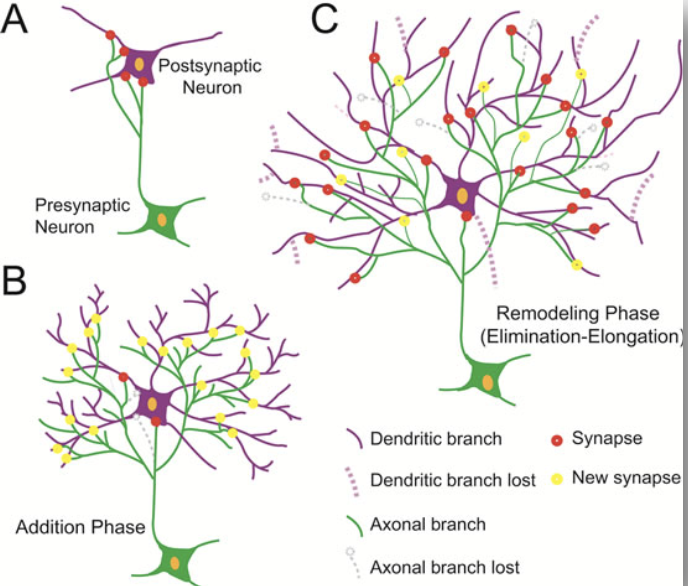
plasticity mechanisms
synaptic plasticity
homosynaptic plasticity:
heterosynaptic plasticity:
homosynaptic plasticity: produces changes in communication at the synapses that were directly activated at the time of information transfer
only neurons that are specifically innervated undergo changes in synaptic plasticity
*heterosynaptic plasticity: changes at the synapses that were not active during the information transfer
synaptic pathways not specifically stimulated undergo changes
== either of these can result in the strengthening or weakening of connections between neurons, depending on the frequency of firing
cellular mechanisms of long-term potentiation and long-term depression are thought to underlie both of these types of plasticity
thought that *heterosynaptic plasticity helps to regulate excitatory and inhibitory inputs into neuronal networks, creating homeostasis that leads to an optimal environment for learning
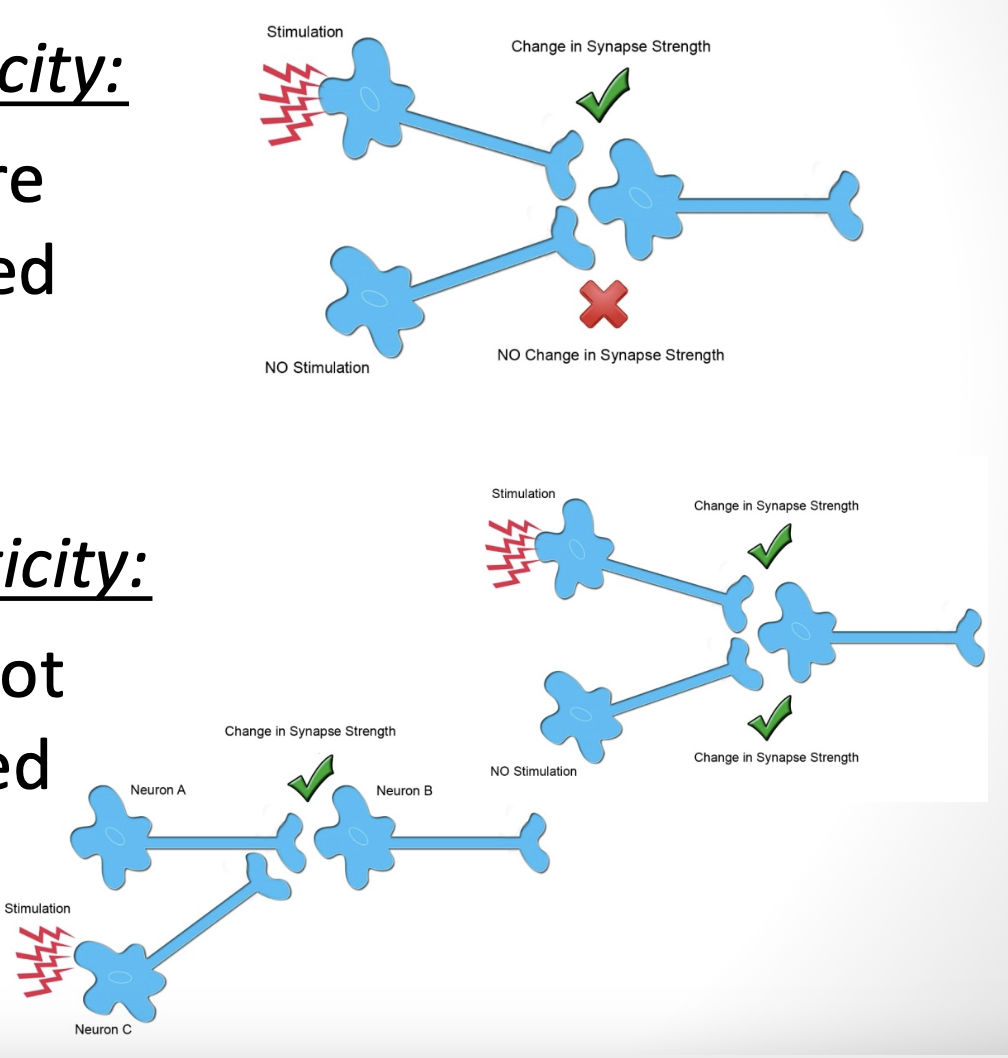
plasticity mechanisms:
***describe the neural mechanisms related to plasticity
synapse strength alterations- LTP; LTD
__ potentiation; synaptic __; __ frequency stimulation
__ potentiation; synaptic __; __ frequency stimulation
***long-term potentiation; ***synaptic strengthening; ***high-frequency stimulation
in the case of ***high-frequency stimulation, ***glutamate is released ***from the presynaptic cell ***onto the postsynaptic cell
—> causing ***depolarization of the cell and ***displacement of the ***magnesium ***from the NMDA receptor
—> once magnesium is displaced, ***calcium ions can flow through the NMDA receptors
—> *large ***influx of calcium into the post-synaptic membrane receptors ultimately causes ***more AMPA receptors to be inserted into the membrane
—> ***more AMPA receptors to the membrane cause the ***post-synaptic cell to ***respond more strongly to ***future releases of glutamate
==> ***synapse is ***strengthened, and ***potentiation has occurred
***long-term depression; ***synaptic weakening; ***low-frequency stimulation
in the case of ***low-frequency stimulation, ***glutamate is released ***from the presynaptic cell ***onto the postsynaptic cell
—> again, causing ***depolarization of the cell and the ***displacement of the ***magnesium ***from the NMDA receptor
—> again, once magnesium is displaced, ***calcium ions can flow through the NMDA receptors
—> *small ***influx of calcium into the post-synaptic membrane receptors activates proteins, causing ***some AMPA receptors to be brought into the cell
—> w/ ***less AMPA receptors, ***subsequent simulations of the cell will induce a ***weaker post-synaptic response
==> ***synapse is ***weakened, and ***long-term depression has occurred
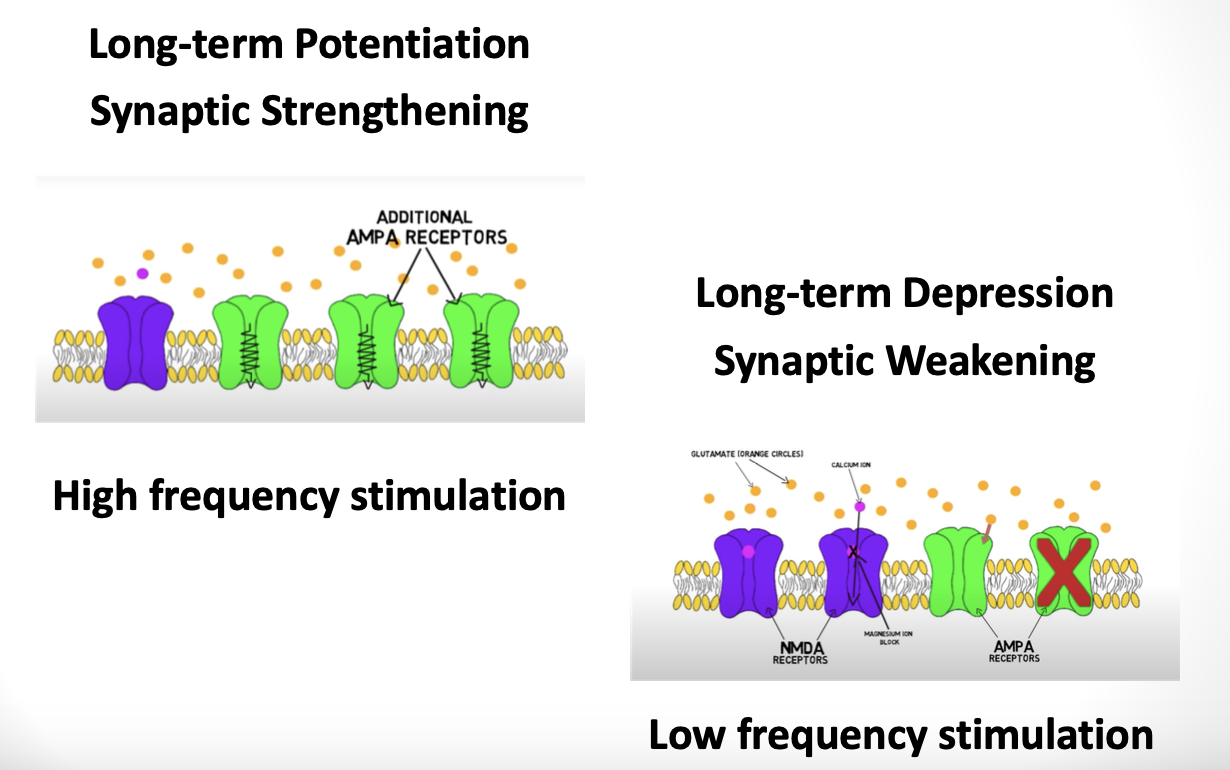
plasticity mechanisms
functional modular plasticity:
***describe mechanisms related to functional modular plasticity, including homologous area adaptation, cross-modal reassignment, map expansion, and compensatory masquerade
homologous area adaptation:
functional modular plasticity= what's happening at the network level, as opposed to the individual/cellular level or what’s happening at individual synapses
allows for the ***shifting of operations from ***one region of the brain ***to another region - specific process is ***carried out by the ***homologous region in the ***opposite hemisphere
thought to happen most often during the ***early critical stages of development and in ***response to injury/disease process
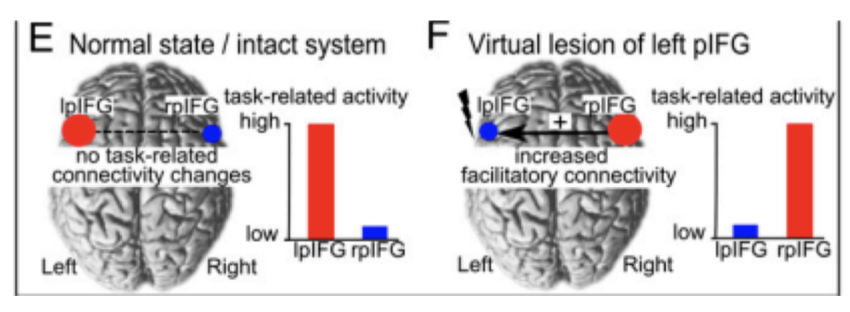
plasticity mechanisms
functional modular plasticity
***describe mechanisms related to functional modular plasticity, including homologous area adaptation, cross-modal reassignment, map expansion, and compensatory masquerade
cross-modal reassignment:
functional modular plasticity= what's happening at the network level, as opposed to the individual/cellular level or what’s happening at individual synapses
an ***area that previously ***processed a specific type of sensory input now ***receives input from another sensory source (i.e., ***intro of new inputs into a ***representational brain region that’s been ***deprived of its main inputs)
often the result of ***decreased sensory input to a cortical region in the ***absence of the typical sensory input
***brain region is ***“recruited” by other sensory modalities
e.g., tactile info being processed in the occipital cortices for people who are blind
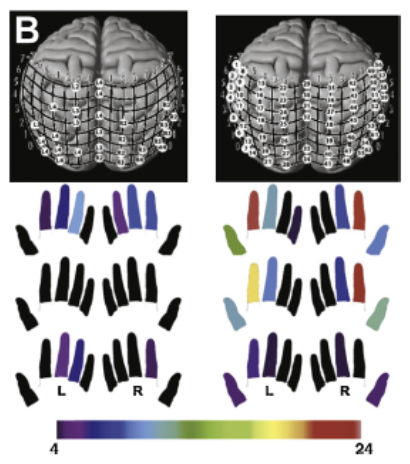
plasticity mechanisms
functional modular plasticity
***describe mechanisms related to functional modular plasticity, including homologous area adaptation, cross-modal reassignment, map expansion, and compensatory masquerade
map expansion:
functional modular plasticity= what's happening at the network level, as opposed to the individual/cellular level or what’s happening at individual synapses
a ***representational area carrying out a specific function ***expands as a ***result of the ***performance of that function or ***repeated exposure to a stimulus
***engagement in an activity causes the brain to change; these ***changes then influence adaptive behavioral responses
e.g., there is map expansion in humans acquiring a new motor skill

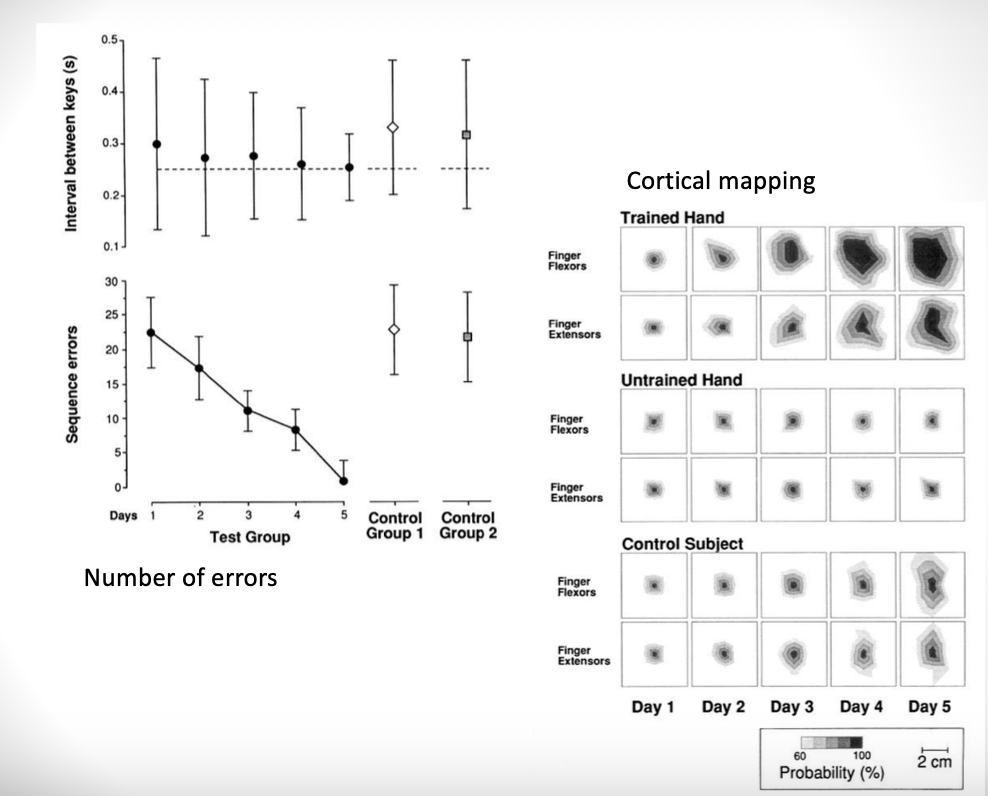
***describe mechanisms related to functional modular plasticity, including homologous area adaptation, cross-modal reassignment, map expansion, and compensatory masquerade
this study shows…
with ***practice, you ***improve, and this is ***due to brain changes
***learning a skill is ***more important than ***just moving
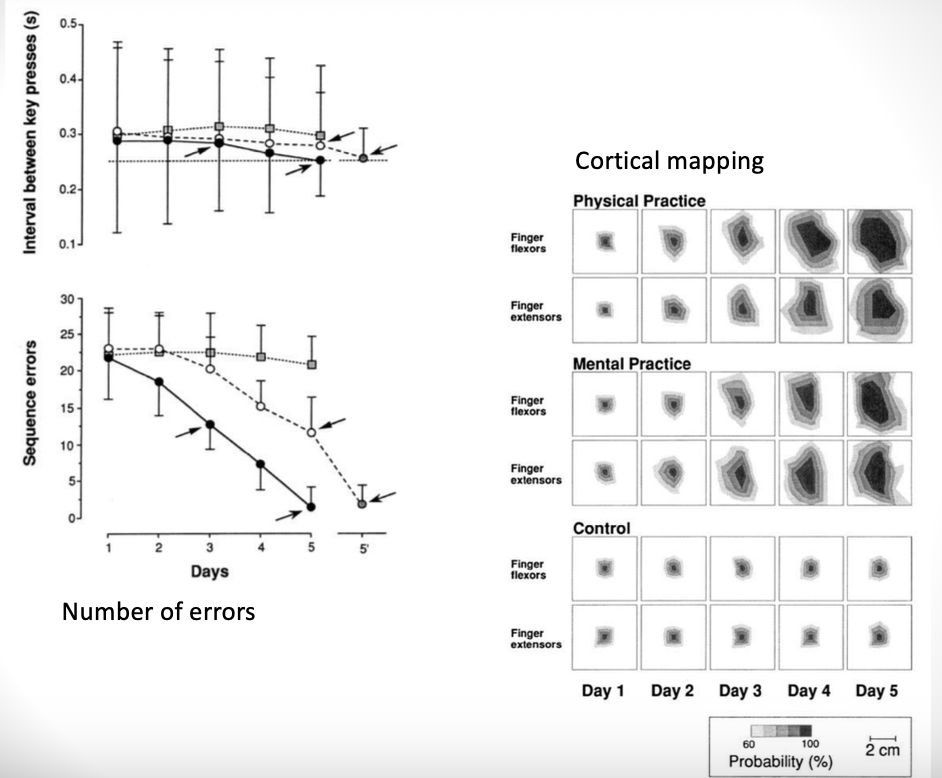
***describe mechanisms related to functional modular plasticity, including homologous area adaptation, cross-modal reassignment, map expansion, and compensatory masquerade
this study shows…
both ***physical practice and ***mental practice ***expand your cortical map (i.e., ***not only engaging in occupation changes the brain, but ***imagining engaging in occupation ***changes the brain)
***mental practice serves as a ***primer
plasticity mechanisms
functional modular plasticity
***describe mechanisms related to functional modular plasticity, including homologous area adaptation, cross-modal reassignment, map expansion, and compensatory masquerade
compensatory masquerade:
functional modular plasticity= what's happening at the network level, as opposed to the individual/cellular level, or what’s happening at individual synapses
***reorganization of ***preexisting neural networks, allowing ***performance of a function to be ***carried out successfully in the ***absence of networks that ***previously supported that function
individual ***uses a ***spared neural network ***to successfully complete the task in the ***absence of the damaged network
how do we promote neuroplasticity: ***10 principles
***use it or lose it
***failure to drive specific brain functions can lead to ***functional degradation
***use it and improve it
***training that drives a specific brain function can lead to ***enhancement of that function
***specificity
the ***nature of the training experience ***dictates the ***nature of the plasticity
***repetition matters
***induction of plasticity ***requires sufficient repetition
***intensity matters
***induction of plasticity ***requires sufficient training intensity
***time matters
***different forms of plasticity ***occur at different times during plasticity
***salience matters
the ***training experience must be ***sufficiently salient to induce plasticity
***age matters
training-induced ***plasticity ***occurs more readily in ***younger brains
***transference
***plasticity in response to 1 training experience ***can enhance the acquisition of ***similar behaviors
***interference
***plasticity in response to 1 experience ***can interfere with the acquisition of ***other behaviors
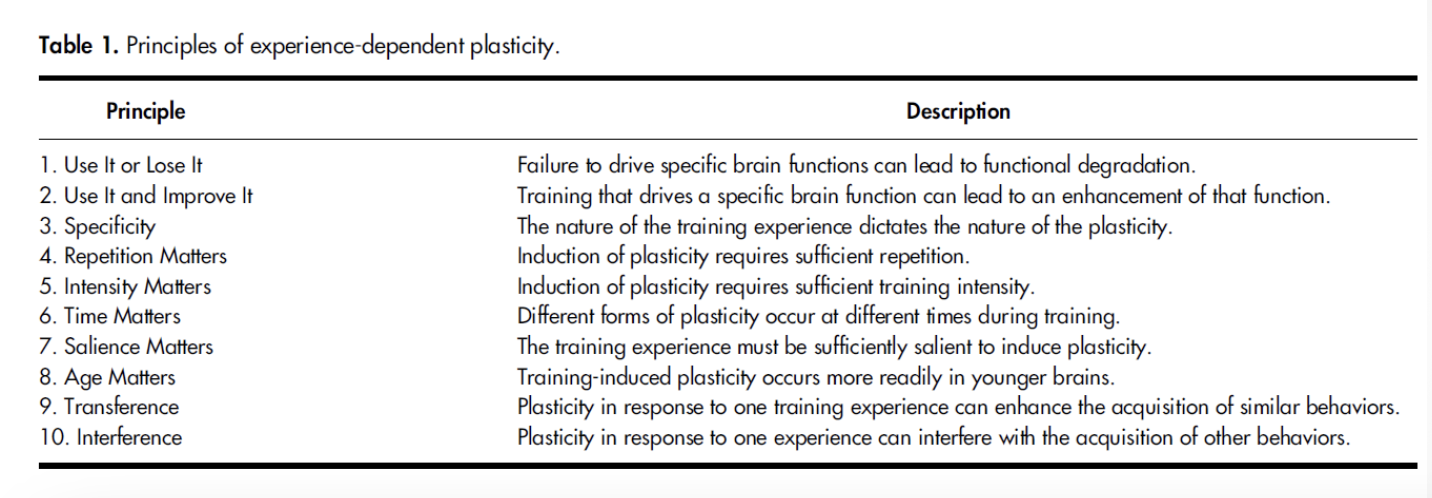
promoting plasticity
upper limb recovery post-stroke
prevalence and impact of motor impairments after stroke
motor impairments impact activity and participation after stroke
prevalence and impact of motor impairments after stroke
50% had hemiparesis
30% were unable to walk without some assistance
26% were dependent in activities of daily living
motor impairments impact activity & participation after stroke
upper limb motor impairments are prevalent and they prevent the use of the arm and hand for daily activities
strong relationship between upper limb function and activity and participation
quality of life is higher among patients with better motor
functioning as compared to those with worse functioning
promoting plasticity: ***how can activity-dependent plasticity be amplified? OT!!
maximize activity-dependent plasticity
OT!
***train the impaired/paretic limb (w/ skilled limb movements) & ***avoid compensation
***start early
***training should be ***high-dose, ***include lots of repetition (but still have variability/novelty), & ***challenge/motivate/stimulate the participant
should also involve ***goal-directed activities (***functional, ***motivating, ***stimulating, ***challenging, etc.), aimed at reducing impairments
e.g., reach to grasp items of various sizes placed in various locations in the workspace- not 1 item it 1 location over and over again

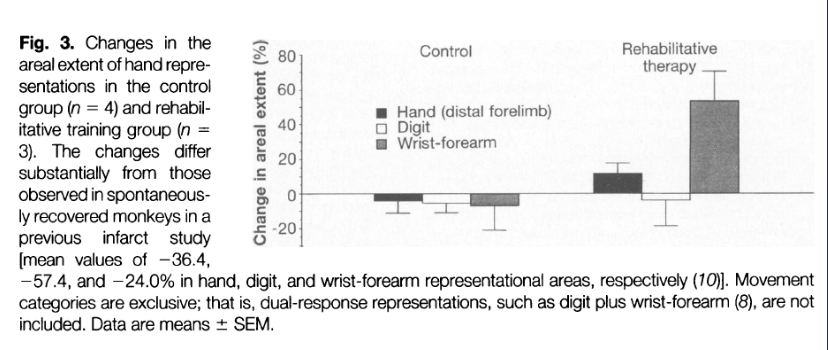
promoting plasticity
there is cortical reorganization that results from the ischemic event and then expands with training
after training, spared digit, wrist, and forearm representation all increased
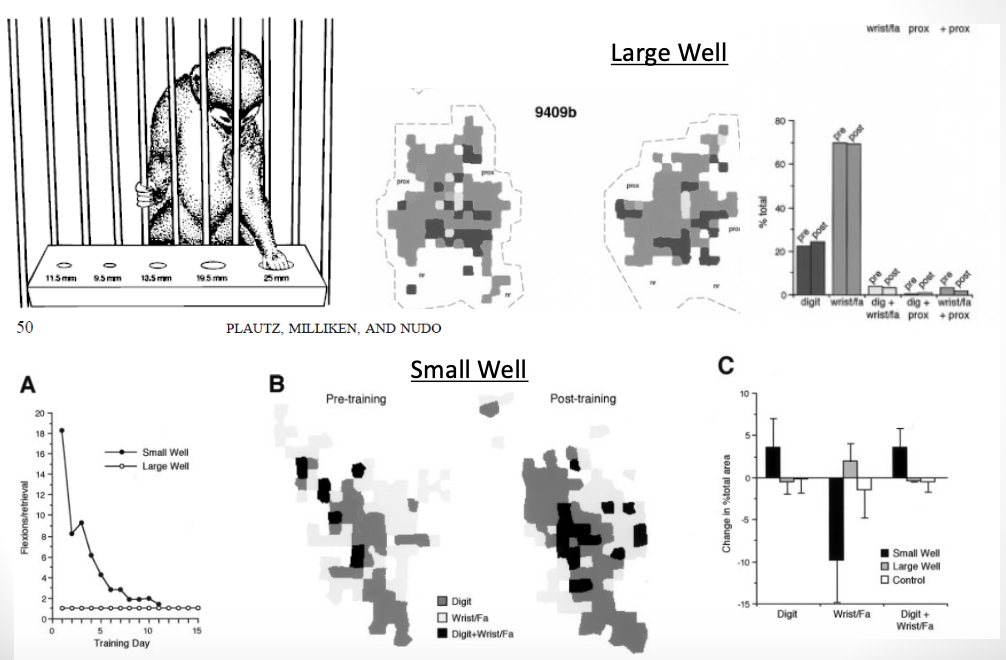
promoting plasticity
challenge drives plasticity with learning, not just repetition
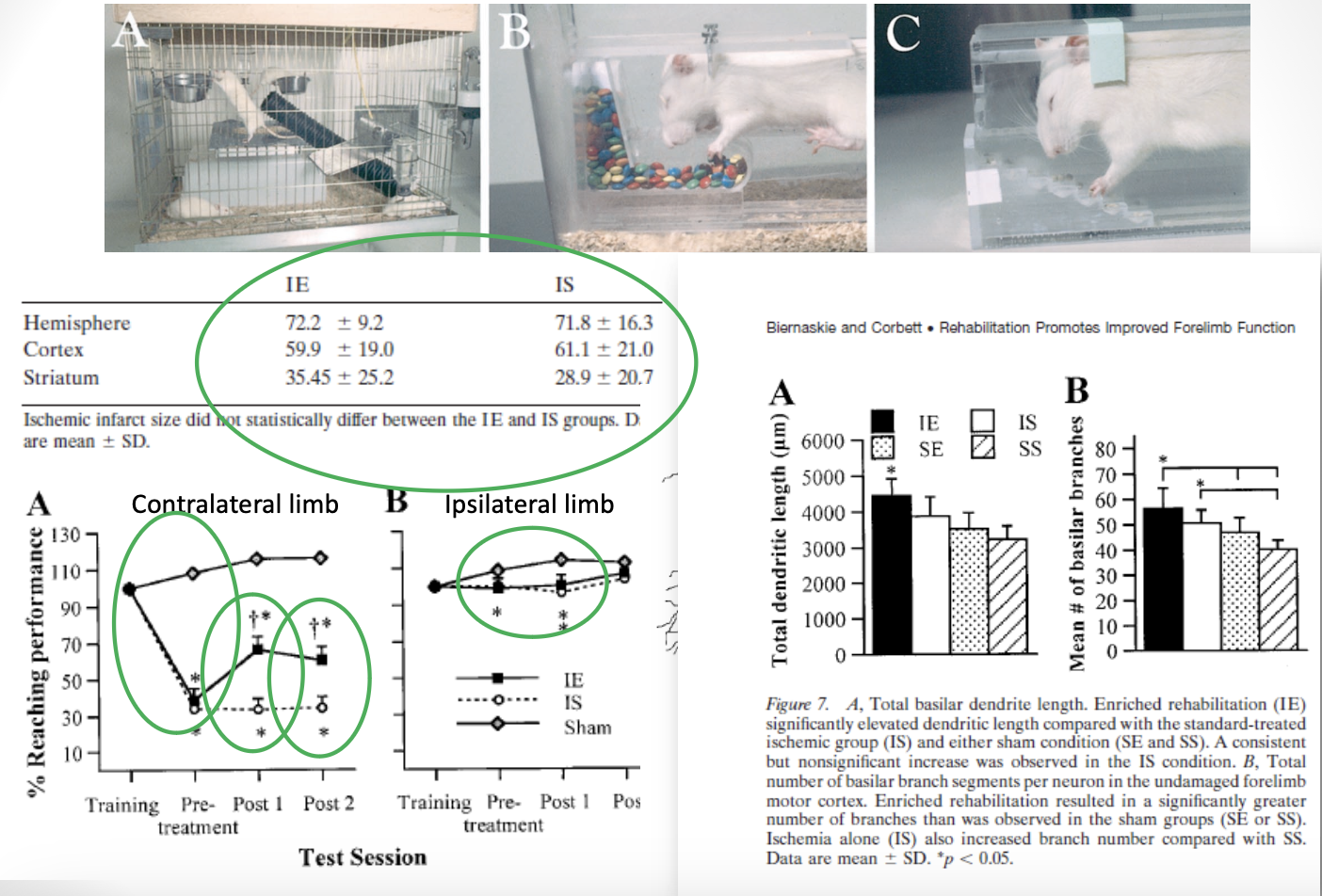
promoting plasticity
total dendritic length is increased in the rats living in the enriched-environment, over the standard-environment
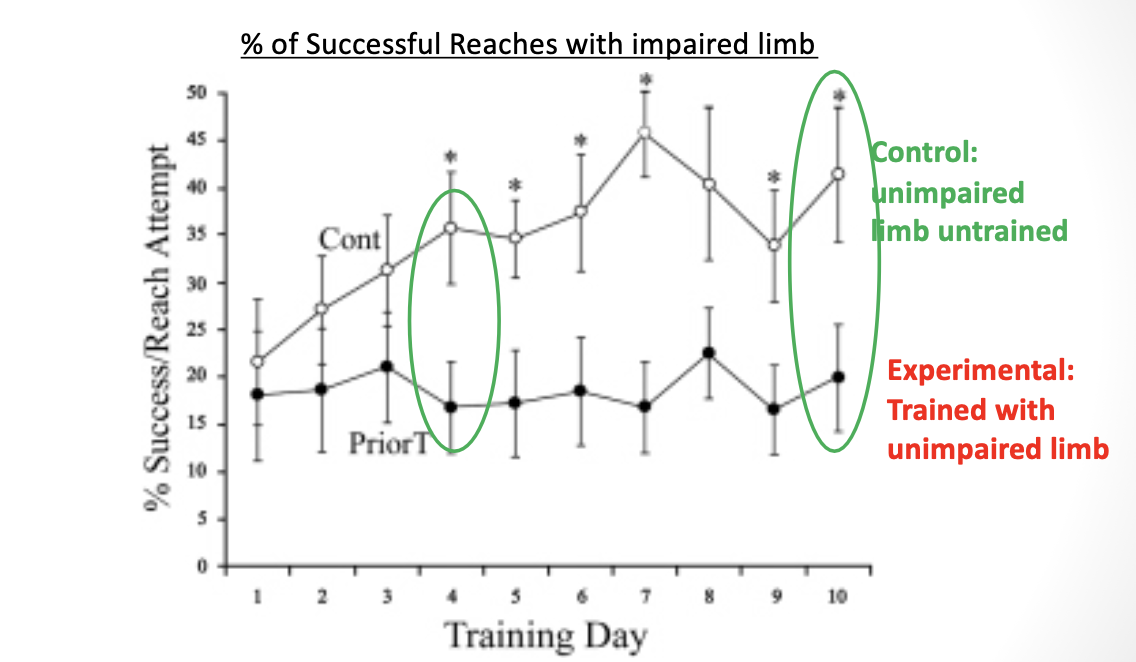
promoting plasticity
we want to avoid compensation; there is a competitive process in experience-dependent neural restructuring after brain damage, and even early compensatory use of the unimpaired limb can later affect training of the impaired limb
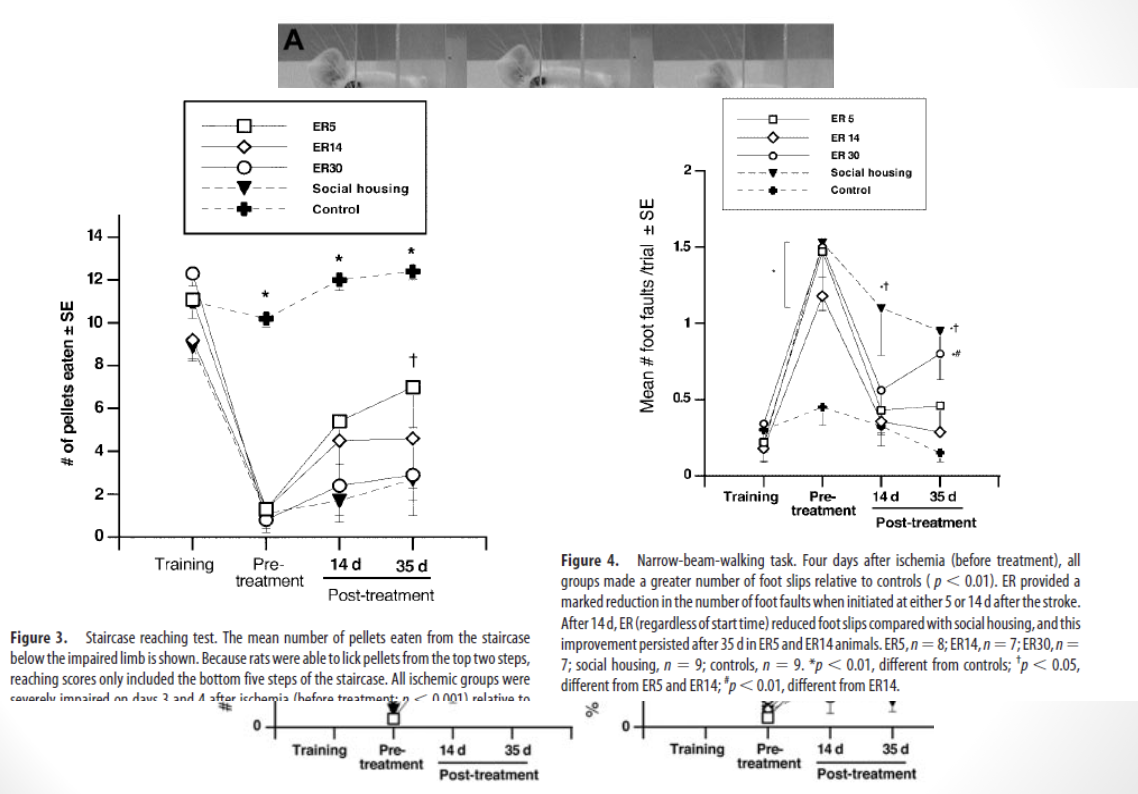
promoting plasticity
post-stroke brain displays a heightened sensitivity to rehabilitative experiences early after the stroke, but then declines with time
rehab for stroke patients should be early
bridging the gap: task-oriented training
(rehab programs pictured)
not only is it feasible, but it’s effective
outcomes improved UE function
retained at 1 month post-treatment in the outpatient setting
no adverse effects, in terms of pain or fatigue, were reported
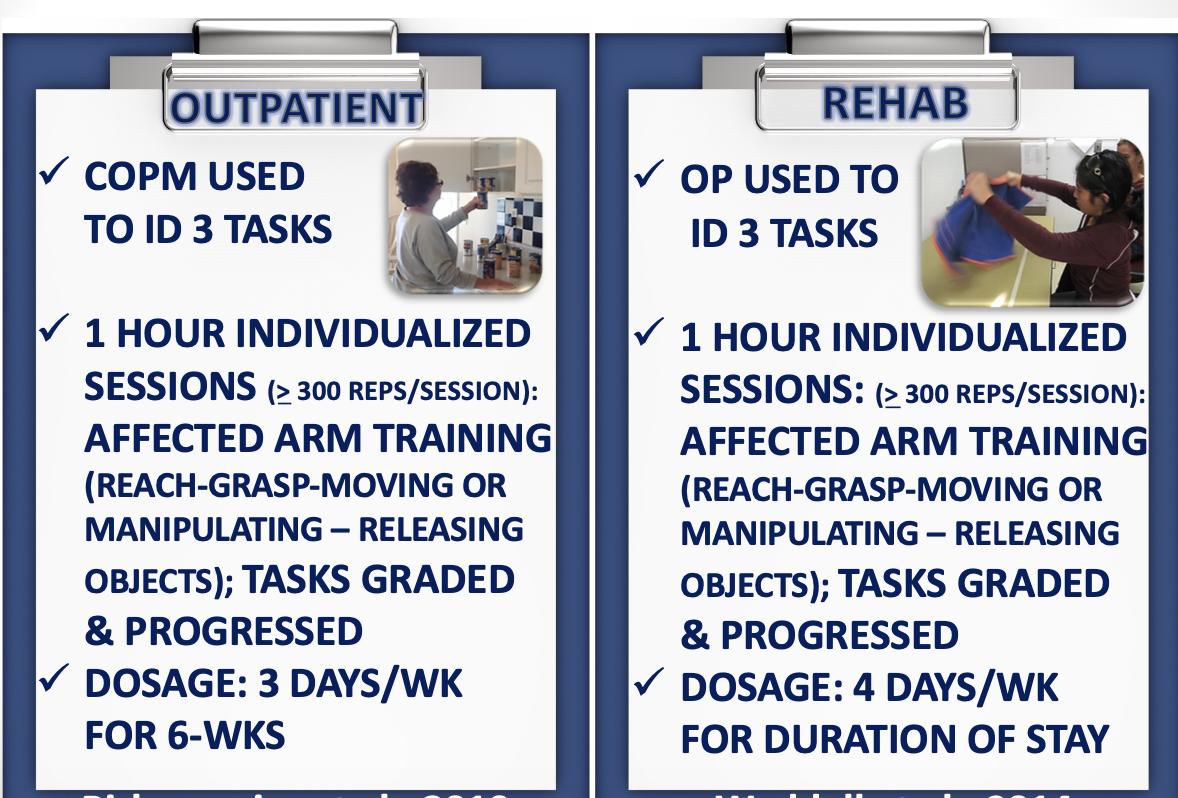
bridging the gap: task-oriented training
***task gradation and ***progression
tasks graded to match motor capabilities: ***challenge but ***don’t overwhelm (e.g., target 1: take repetition in 6-15 seconds)
grade up:
achieved >= 100 repetitions in < 15 mins- use graded up version of task performed for an additional couple of minutes
achieved >= 100 repetitions in < 15 mins on 2 occasions– use graded-up version of task
grade down:
unable to achieve 50 repetitions of the task within 15 minutes or if they experience extreme fatigue
***addition of new tasks: 1x/week based on need/desire
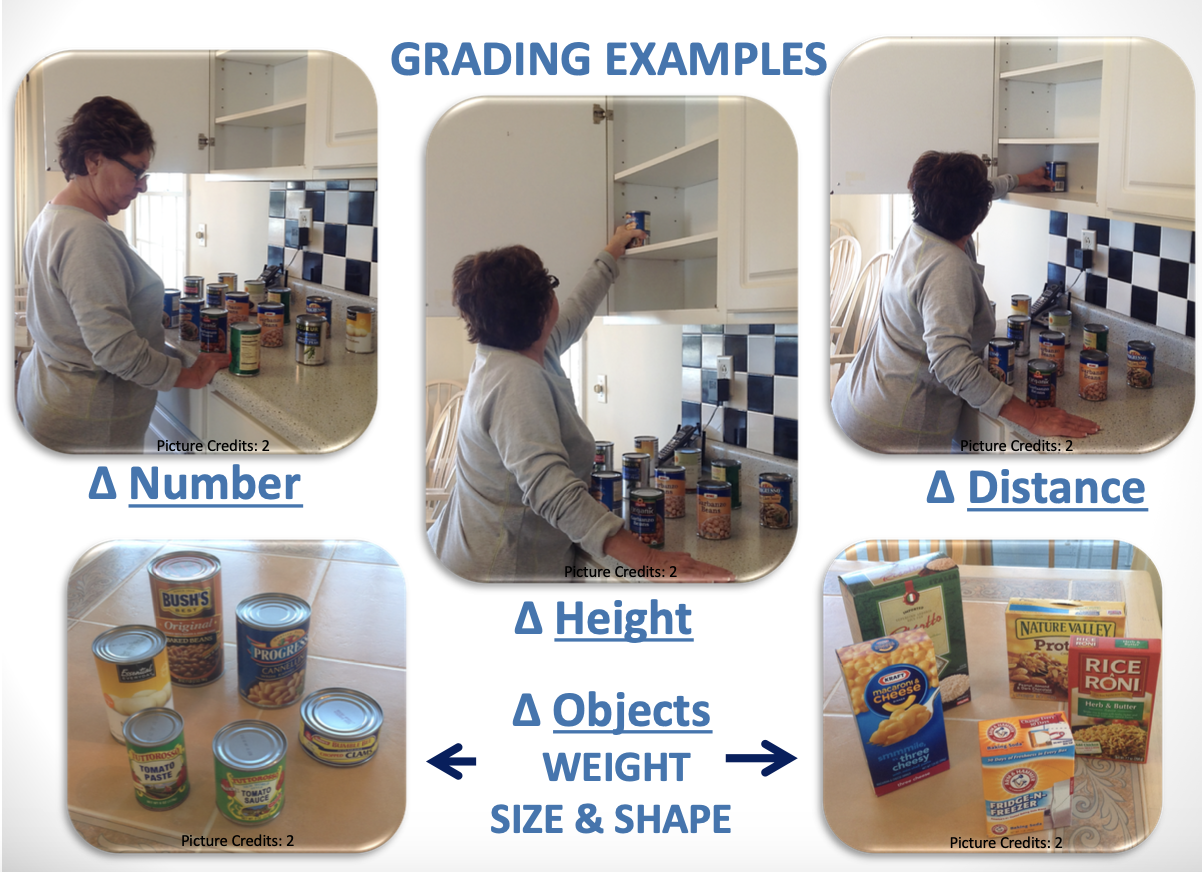
bridging the gap: task-oriented training
example: task 1: lifting cans/retrieving cans
***grading up/***grading down examples
changing the number of cans lifted
changing the height of the cabinet
changing the distance reached/depth the cans are placed in the cabinet
changing the object being moved itself
